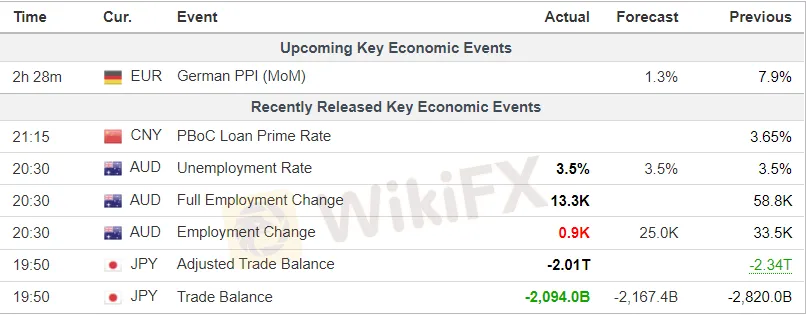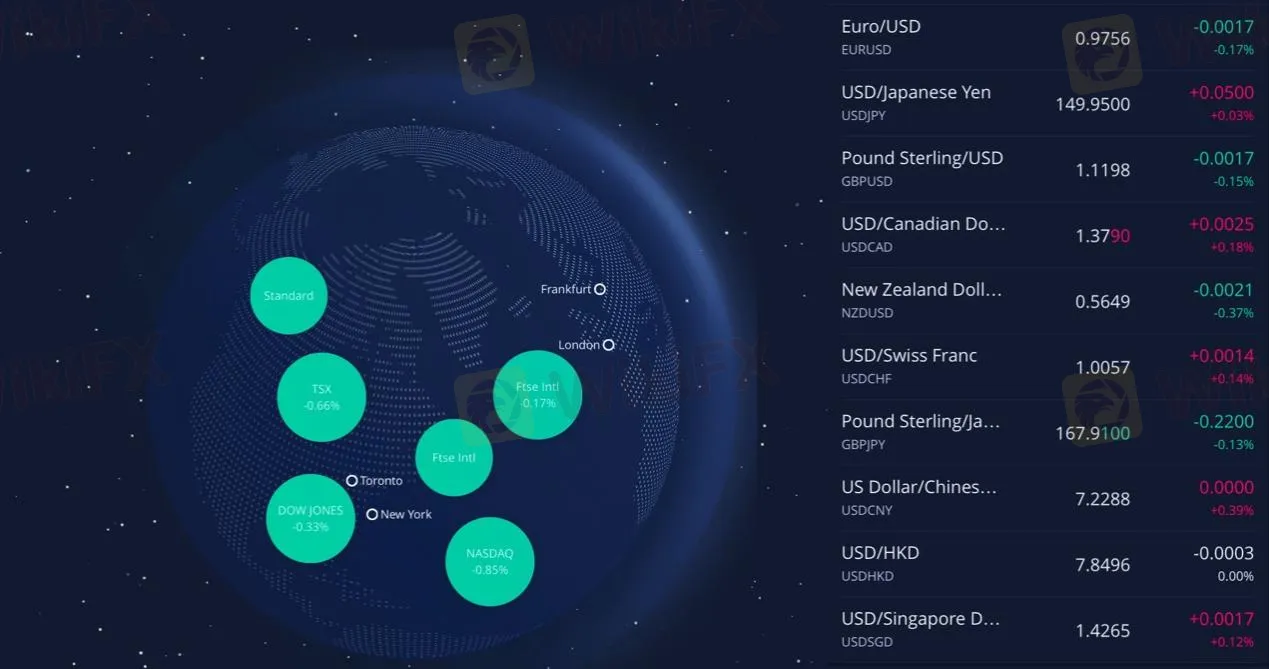Mohicans markets:MHM Today News
Abstract:On Wednesday, October 19, the dollar index rose 1% in the day to close at 113, up 0.776% to 112.92. EUR/USD fell nearly 1% and fell below 0.98; The dollar/yen further approached the 150 level, hitting a 32 year low for three consecutive days this week; GBP/USD fell by more than 100 points, once falling below 1.12. The 10-year US bond yield climbed to 4.138%, breaking 4.1% for the first time in 14 years. The 30-year UK bond yield fell by more than 30 basis points and lost 4%.
![第一篇[英语]](https://wzimg.ruiyin999.cn/fb_article/2022-10-20/638018737067556526/FB638018737067556526_836719.jpg-article598)

October 20, 2022 - Fundamentals Reminder
☆ The editor of the British Telegraph said on social media that Conservative MPs from the British 1922 Committee would meet on the 20th to discuss the leadership crisis of the Conservative Party.
☆ 16:30 The deputy governor of the Bank of England, Robert Broadbent, delivered a speech.
☆ At 20:30, the number of people applying for unemployment benefits in the week from the United States to October 15, and the manufacturing index of the Federal Reserve of Philadelphia in October.
☆ 24:00 The Federal Reserve Hack delivered a speech on the economic outlook.
☆ At 01:45 the next day, Governor Cook of the Federal Reserve delivered a speech.
☆ At 02:30 the next day, New York crude oil completed the final trading on the floor in November.
Marketoverview
——Source: jin10&Bloomberg

On Wednesday, October 19, the dollar index rose 1% in the day to close at 113, up 0.776% to 112.92. EUR/USD fell nearly 1% and fell below 0.98;
The dollar/yen further approached the 150 level, hitting a 32 year low for three consecutive days this week; GBP/USD fell by more than 100 points, once falling below 1.12. The 10-year US bond yield climbed to 4.138%, breaking 4.1% for the first time in 14 years. The 30-year UK bond yield fell by more than 30 basis points and lost 4%.
Spot gold fell below US $1630/oz from above 1654 for the first time since September 28, closing 1.41% lower at US $1629.19/oz; Spot silver fell 1.66% to US $18.46/oz.
Crude oil rose, and Biden's speech failed to calm the market. WTI crude oil rose 3% to touch US $86/barrel, while Brent crude oil rose to US $93/barrel. By the end of the day, WTI crude oil had closed 2.01% higher at US $85.88 per barrel, while Brent crude oil had closed 1.37% higher at US $92.34 per barrel. US natural gas futures fell nearly 5% in October, hitting a three-and-a-half month low for four consecutive days. The European benchmark Dutch TTF natural gas futures fell 5%, hitting a four month low for five consecutive days.
US stocks opened low and closed low. The Dow closed 0.33% lower, the Nasdaq closed 0.85% lower and the S&P 500 closed 0.67% lower. Popular Chinese stocks generally closed lower, “Weixiaoli” closed down about 11%, Bilibili closed down about 10%, and Alibaba closed down about 6%. Netflix closed up about 13% after its performance. European stocks generally closed lower, and Germany's DAX30 index fell 0.19%; Britain's FTSE 100 index fell 0.17%; France's CAC40 index fell 0.43%;
Europe's Stoxx 50 index closed 0.21% higher; Spain's IBEX35 index fell 0.34%; Italy's FTSE MIB closed 0.22% lower.
Market Focus
——Source: jin10 & Bloomberg
1.Biden confirmed in his speech that the U.S. will release 15 million barrels of oil from the SPR and offer additional oil for sale if needed, but did not announce any other measures that could drive down oil prices, such as plans to restrict fuel exports.
2.According to two people familiar with the matter, the British Conservative Party Whip Wendy Morton resigned from the British government led by Prime Minister Alex Truss.
3.UK CPI recorded an annual rate of 10.1% in September, returning to a 40-year high in July; the monthly rate of CPI rose by 0.5%. UK monthly rate of retail price for September 0.7%, expected 0.5%.
4.This years hawkish voting members, St. Louis Fed President Bullard: the Fed may choose to bring forward the 2023 tightening to 2022, the Fed should not react to the stock market decline.
5.The Federal Reserve‘s Beige Book of economic conditions: the nation’s economic activity has expanded slightly on net since the last report; however, the situation varies across industries and regions, and inflation is expected to moderate generally.
6.Russian President Vladimir Putin signed an order to put Donetsk, Luhansk, Kherson and Zaporozhye into a state of war.
7.The EU will propose a new electricity market design in the first quarter of next year, severing the link between natural gas and electricity prices. According to the German business newspaper: Germany plans to implement a cap on electricity prices in accordance with the practice of capping natural gas prices.
8.Turkish President Recep Tayyip Erdogan said that Turkey and Russia agreed after consultation that European countries can use Russian natural gas through Turkey. The Turkish president said he has agreed with Putin on the matter of natural gas hub.
9.Indian media said that India is not inclined to join the global initiative to impose a price cap on Russian oil at this time because India receives a big discount on crude oil imports from Russia.
10.The U.S. EIA crude oil inventories decreased by 1.725 million barrels for the week until October 14, expected to increase by 1.38 million barrels; the SPR inventory decreased by 3.564 million barrels to 405.1 million barrels for the week, which was the lowest since the week of June 1, 1984; the U.S. domestic crude oil production increased by 100,000 barrels to 12 million barrels per day for the week;crude oil exports increased by 1.266 million barrels per day to 413.8;Separately, EIA data showed that U.S. diesel stocks were sufficient for only 25 days of supply, which was the lowest level since 2008. Meanwhile, demand indicators remain at a two-year high, as trucking, agriculture and heating use increases.
11.The U.S. mortgage market index fell 4.5% to 204.6 for the week ended Oct. 14, which was the lowest level since 1997.
12.Eurozone monthly rate of CPI for September recorded 1.2%, which was the largest increase since March 2022. Eurozone annual rate of CPI for September finally recorded 9.9%, which was the highest value since the record.
13.Tesla revenue of $21.45 billion in the third quarter, the market estimate of $22.09 billion; net profit of $3.292 billion, compared with $1.618 billion a year ago, the market expects $3.19 billion; Auto business gross margin of 27.9% in the third quarter, the market expects 28.4%.
14.U.S. grain traders Adi Meng (ADM): soybean exports increased due to the increase in the Brazilian harvest, exports may hit a record high.
15.TSMC is considering expanding its Japanese production capacity to produce more advanced chips.
16.Saudi Aramco Oil reportedly will continue to promote the IPO of the oil trading business unit.
17.Russias Ministry of Agriculture announced that Russia's grain production reached a record 147.5 million tons.
18.The U.S. Mississippi River part of the river closed again, and the U.S. Midwest supply chain faces major restrictions.
Institutional Perspective
——MHMarkets ETA
1.Royal Bank of Canada: As the yen approaches 150 per dollar, the chances of intervention are rising
2.Commerzbank: the dollar rose sharply against the yen is only a matter of time
3.Commerzbank: BOE rate hikes may not be enough to control inflation, the pound will remain under pressure
4.BMO Capital: If the leadership change, the pound is expected to rebound
Statement | Disclaimer
Disclaimer: The information contained in this material is for general advice only. It does not take into account your investment goals, financial situation or special needs. Mohicans Markets has made every effort to ensure the accuracy of the information as of the date of publication. Mohicans Markets makes no warranties or representations regarding this material. The examples in this material are for illustration only. To the extent permitted by law, Mohicans Markets and its employees shall not be liable for any loss or damage arising in any way, including negligence, from any information provided or omitted from this material.The features of Mohicans Markets products, including applicable fees and charges, are outlined in the product disclosure statements available on the Mohicans Markets website and should be considered before deciding to deal with these products. Derivatives can be risky and losses can exceed your initial payment. Mohicans Markets recommends that you seek independent advice.
Mohicans Markets, (Abbreviation: MHMarkets or MHM, Chinese name: Mai hui), Australian Financial Services License No. 001296777.

Read more

Mohicans markets:MHM European Market
Spot gold weakened slightly during the Asian session on Thursday (April 6), hitting a two-day low of $2007.89 per ounce and now trading near $2014.15. A series of weak economic data has fueled fears of an impending recession in the US, giving safe-haven support to the dollar. And some dollar shorts took profits, and gold bulls also took profits ahead of Good Friday and the non-farm payrolls data, putting pressure on gold prices.

Mohicans markets:MHM Today News
On Wednesday, as the less-than-expected March "ADP" data and non-manufacturing PMI data fueled market concerns about an economic slowdown and spurred bets that the Federal Reserve could slow interest rate hikes. Spot gold continued to brush a new high since March last year, which was the highest intraday to $2032.13 per ounce, and then retracted most of the day's gains, finally closing up 0.01% at $2020.82 per ounce; spot silver hovered around $25 during the day, finally closing down 0.21% at $2

Mohicans markets:MHM European Market
Spot gold oscillated slightly lower during the Asian session on Tuesday (April 4) and is currently trading around $1980.13 per ounce. The dollar index rebounded mildly after a big drop overnight, putting pressure on gold prices. However, this week will see the non-farm payrolls report, there is no important economic data out on Tuesday, and the market wait-and-see sentiment is getting stronger.

Mohicans markets :MHM Today News
On Monday, in OPEC + members unexpectedly cut production reignited market concerns about long-term inflation and sparked uncertainty about the Fed's response, the dollar index once up to the 103 mark, and then on a "vertical roller coaster", giving back all the gains of the day and once lost 102 mark, finally closed down 0.53% at 102.04; U.S. 10-year Treasury yields rose and then fell, as data showed that the U.S. economy continues to slow, it fell sharply in the U.S. session, and once to a low
WikiFX Broker
Latest News
TriumphFX: The Persistent Forex Scam Draining Millions from Malaysians
Lawmakers Push New Crypto ATM Rules to Fight Fraud
2025 WikiFX Forex Rights Protection Day Preview
PH Senator Probes Love Scams Tied to POGOs
Mastering Calm: How to Stay Cool in Forex Trading?
The End of Costly USDT Transfers: Tron Reshapes Stablecoin Transactions
BP\s shareholders want it to make money, not climate policy
2025 SkyLine Guide Thailand Opening Ceremony: Jointly Witnessing New Skyline in a New Chapter
Why does Botbro change the domain name?
Safety Alert: FCA Discloses These 11 Unlicensed Financial Websites
Rate Calc


